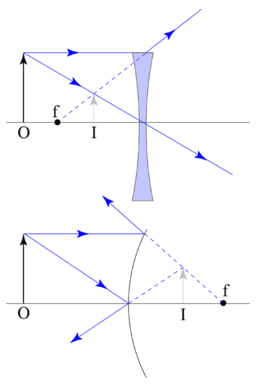Virtual image

Top: The formation of a virtual image using a concave lens. Bottom: The formation of a virtual image using a convex mirror. In both diagrams, f is the focal point, O is the object and I is the image, shown in grey. Solid blue lines indicate light rays. It can be seen that the light rays appear to emanate from the virtual image but do not actually exist at the position of the virtual image. Thus an image cannot be seen by placing a screen at the position of the virtual image.
In optics, a virtual image is an image in which the outgoing rays from a point on the object always intersect at a point. A simple example is a flat mirror where the image of oneself is perceived at twice the distance from oneself to the mirror. That is, if one is half a meter in front of the mirror, one's image will appear to be at a distance of 1 meter away (or half a meter inside or behind the mirror).
To contrast, a real image is an image in which the outgoing rays from a point on the object pass through a single point. It is easiest to observe real images when projected on an opaque screen. A screen is not necessary for the image to form.[1]
- When we look through a diverging lens (at least one concave surface) or look into a convex mirror, what we see is a virtual image. However, if we observe a focused image on a screen inside or behind a converging lens (at least one convex side) or in front of a concave mirror what we see on the screen is a real image because the image really is at the screen's location. If we position ourselves so that the screen is directly between ourselves and the optical device (mirror, lens, etc.), we can remove the screen and still observe the image. A converging lens and concave mirror are also capable of producing virtual images if the object is within the focal length.
- For example, a plane or convex mirror forms a virtual image positioned behind the mirror. Although rays of light seem to come from behind the mirror, light from the source spreads and exists only in front of the mirror. In drawings of optical systems, virtual rays are conventionally represented by dotted lines. Optical rays represent paths on which light actually travels. A virtual ray (the dotted lines) represent perceived paths as seen by an observer looking into the optical device. The light rays do not travel on these dotted paths. A point on the image is located where the virtual rays intersect.
See also
- Real image
- Mirror image
- Reflection
- List of optical topics
References
- ↑ Knight, Randall D. (2002). Five Easy Lessons: Strategies for successful physics teaching. Addison Wesley.